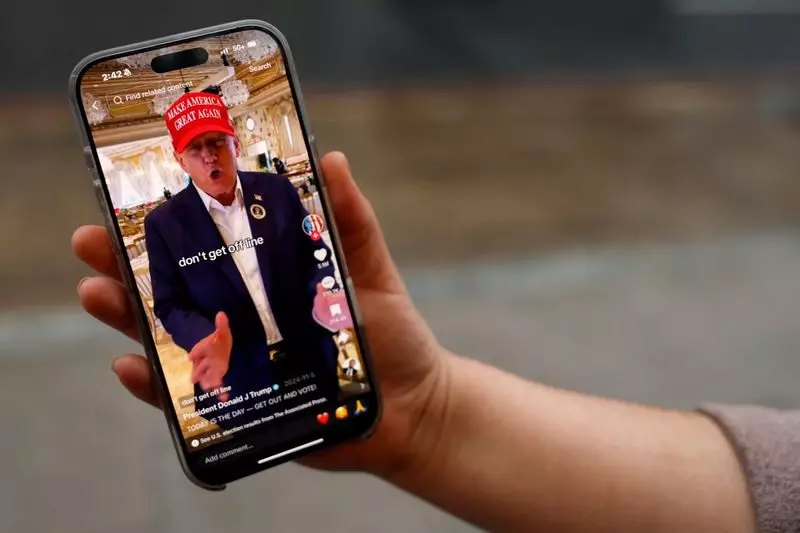In an unexpected twist of fate, TikTok appears set to resume service in the United States following a public announcement from President-elect Donald Trump, who has expressed intent to restore the app’s access when he assumes office. The news comes amidst fraught U.S.-China relations and urgent national security concerns that have shadowed TikTok’s operations in the country. What was once a vibrant platform for creativity and connection has now morphed into a contentious battlefield between government power and corporate interests.
On a recent Sunday, TikTok confirmed that it would be restoring its services to American users, a significant turnaround from the discontinuation that had been enacted due to a new law aimed at protecting national security. In a statement of gratitude towards Trump, the platform acknowledged his role in facilitating this unexpected revival while emphasizing the negative ramifications that a ban would impose on over 170 million users and countless small businesses reliant on the app for their livelihood.
What this confirms is that TikTok is deeply interwoven into the fabric of American social media, serving as a primary conduit for many businesses and a means of expression for young users. However, this service restoration is not without its critics. Amid the applause from TikTok’s management is a palpable concern regarding the protections it might receive from governmental oversight. Such favoritism raises substantial questions about the ethical implications of corporate favoritism manifesting in government policy, particularly when security risks are at play.
This recent development has its roots in a complicated relationship between TikTok and the concerns voiced by U.S. officials regarding the app’s ownership by the Chinese company ByteDance. Previous administrations expressed fears that users’ data might be exploited by the Chinese government, leading to national security concerns and subsequent calls for drastic measures, including outright bans of the platform.
The executive order suggested by Trump, which would reportedly stabilize the situation temporarily, is reminiscent of earlier attempts he made during his previous term when he sought to force a sale of TikTok’s U.S. operations through divestiture. Trump’s unexpected affection for the platform — stemming from its ability to engage younger voters — complicates the narrative further. While TikTok may indeed serve as a valuable asset in a political campaign, its fate should not hinge solely on its utility in domestic politics.
Legal Ramifications: New Laws and Lingering Questions
As the TikTok debate unfolds, the DRAM (Diverse Resource Allocation Model) law passed overwhelmingly by Congress grants significant authority to the Trump administration, allowing either a ban or a forced sale of apps under Chinese ownership. Interestingly, the contention remains among Republicans themselves on the issue of temporarily restoring TikTok without satisfying the new legislation’s requirements. Critics within the same party argue that this potential easing of restrictions can set a precarious precedent for other national security matters.
The law has not gone unchallenged, as the Chinese Embassy in Washington has condemned these moves as offensive state power exerted against a legitimate business. As these tensions mount, one must ponder whether such duplicity perpetuates the sense of distrust that could lead to more conflict between the two superpowers in the tech realm.
With the threat of a ban looming, many TikTok users swiftly turned to alternatives, showcasing a remarkable agility characteristic of digital culture. Platforms such as RedNote began attracting attention, while competitors like Meta and Snap have seen their market shares swell in anticipation of an influx of displaced TikTok users. This kind of exodus showcases the market dynamics at play, emphasizing that the disappearance of one platform could accelerate the visibility and growth of established or emerging rivals.
Yet, what cannot be overlooked is the emotional impact on users, many of whom regard TikTok as more than just a social media app — it is a vibrant community where they express creativity and connect with likeminded individuals. Firms relying on TikTok for their marketing strategies have also rushed to devise alternate plans, reflecting the underlying anxiety that technology firms experience in this fast-paced digital landscape.
As TikTok prepares for a potential reinstatement, the app’s future remains shrouded in uncertainty. The involvement of high-profile figures in negotiations and proposed partnerships foreshadows a convoluted path ahead, filled with speculation and maneuvering. Whether TikTok will eventually sever ties with its Chinese parent company or develop a more distinctly American identity remains to be seen.
This situation exemplifies the growing trend of digital monopoly and regulatory oversight threading through tech industries worldwide, indicating a future where social media platforms may find themselves straddling the line between being community hubs and potential targets of governmental regulation. The implications of such developments will undoubtedly shape the interplay between business interests, national security, and user experiences in the years to come, forcing all stakeholders to reckon with the evolving landscape of digital engagement.

